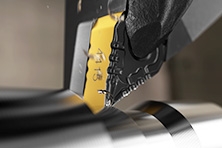Introduction
In producing a vast range of parts from widely differing workpiece materials, manufacturers utilize a variety of machining processes. Regardless, the common goal of all manufacturers is to create a certain number of workpieces of a desired quality, in a specified amount of time and at an appropriate cost.
Many manufacturers achieve that goal by following a narrow-perspective model that begins with tool selection and application and solving problems on a reactive basis. Reversing that approach, however, can reduce costs and increase efficiency. Instead of waiting for problems to arise and then making adjustments to individual machining operations, manufacturers should focus first on proactive preplanning aimed at eliminating rejected parts and unplanned downtime. After a stable and reliable process has been established, applying the concepts of production economics can help manufacturers find a balance between production rate and manufacturing costs. Then, building on the foundation of secure, economically strong operations, manufacturers can select tools and cutting conditions that will fully optimize the machining process.
Production economics
Prior to taking steps to optimize metal cutting, it is essential that the processes are secure and reliable, minus defective parts or unplanned downtime. Achieving process security requires creation of a stable production environment. The areas manufacturers must analyze include machine tool maintenance, CAM programming, tool holding systems and coolant application. Work handling automation such as pallet or robotic part load/unload systems could be part of the evaluation as well.
The art and science of production economics focuses on assuring maximum security in, and predictability of, the manufacturing process, while maintaining highest productivity and lowest production costs. When the metal cutting process and environment are secure and predictable, production economics becomes a two-dimensional pursuit: finding a balance between production output and manufacturing costs that is appropriate for a manufacturer’s specific situation. For example, in mass production of simple parts, maximizing output at minimal costs may be the primary consideration. On the other hand, in high-mix, low-volume manufacturing of valuable complex parts, the emphasis must be on total reliability and accuracy before addressing manufacturing costs.
Micro versus macro
The traditional approach to maximizing metal cutting output involves a narrow-perspective micro model based on optimization of individual tools in individual operations. Macro models, on the other hand, consider manufacturing processes from a broader perspective. These models concentrate on the total floor-to-floor time required to produce a given workpiece.
The relationship between the micro and macro economic models can be compared to an artist’s perspective when creating a painting. The micro model concentrates on individual details, in the same way that an artist would concentrate on individual brush strokes. The macro model steps back and views the part production process overall, as in viewing a painting in its entirety. It is clear that attention to detail is necessary, but not at the price of ignoring the overall purpose of the effort.
Hidden costs
Exaggerated fixation on detail can distract attention from the final outcome of the process. For instance, it is a disadvantage to reduce cutting time by ten seconds when it is achieved with an extra tool that adds ten minutes in setup and indexing time. Similarly, working to achieve product quality beyond customer requirements will increase costs and production time. Almost seriously, one could ask, “How long would it take, and how much would it cost, to produce the worst workpiece possible, which is still functionally acceptable?”
Operating costs
Models for machining costs can also represent micro- and macro-perspectives. Micro-models consider cutting processes from a narrow viewpoint, linking cutting conditions directly to cutting costs. Macro-economic models work from a broader perspective, emphasizing the overall time required to produce a given workpiece.
Manufacturers measure production rate in various ways, from workpieces completed over a period of time to the total length of time required to finish an operation. Many factors affect production rate, including workpiece geometry requirements and material characteristics, product flow throughout a facility, personnel input, maintenance, peripheral equipment and environmental, recycling, and safety issues.
Some elements of manufacturing costs are fixed. Workpiece complexity and material generally dictate the type and number of machining operations required to make a part. The costs of acquiring and maintaining a facility’s machine tools and the power to run them are basically fixed costs. Labor costs are somewhat more flexible, but are effectively fixed for at least the short term. These costs must be offset with revenue from the sale of machined components. Raising production rate – the speed at which workpieces are converted into finished products – can offset fixed costs.
Individual optimization
After the overall productivity and cost efficiency picture of a process is balanced and optimized on a macro basis, manufacturers can achieve further improvements by careful optimization of individual operations. Cutting conditions – namely depth of cut, feed rate and cutting speeds – play a key role in balancing productivity and costs. Any or all of the three can contribute to reductions in machining time, but the impact of each on reliability of the process varies widely. Depth of cut essentially has no effect on tool life. Feed rate affects tool life slightly. However, the impact of cutting speed on tool life, as well as on the reliability of the cutting process, is significant.
Many shop managers believe that simply increasing cutting speeds will produce more parts per period of time and thereby reduce manufacturing costs. Usually that is true, but tradeoffs are involved. In general, the faster an operation runs the less stable it becomes. High speeds generate more heat that affect both tool and workpiece. Tool wear occurs faster and is less predictable, and tool wear or vibration can cause part dimensions to vary and surface finish to decline.
A tool may break and mar the workpiece. In addition, a process operating at the outer boundaries of reliability is typically unable to run untended or semi-tended, eliminating a potential source of labor savings. Extremely high cutting speeds and aggressive machining parameters can increase machine maintenance costs and even downtime resulting from machine failures.
Recognizing these issues, American mechanical engineer F.W. Taylor, at the beginning of the 20th century, developed a model for determination of tool life. The model shows that for given combination of depth of cut and feed there is a certain window for cutting speeds where tool deterioration is safe, predictable and controllable. Taylor’s model makes it possible to quantify the relationship between cutting speed, tool wear and tool life, balancing cost efficiency and productivity and providing a clear picture of the optimum cutting speed for an operation.
In general, manufacturers should select the largest depths of cut and highest feed rates possible for each operation, subject to the stability of the tool clamping, workpiece fixturing and machine tool, as well as the machine tool’s power. Operational safety, in regards to chip formation and evacuation, vibrations and workpiece deformation, also must be considered. A balanced approach involves reduced cutting speeds matched with proportional increases in feed rate and depth of cut. Utilizing the largest depth of cut possible reduces the number of cutting passes required and thereby reduces machining time. Feed rate should be maximized as well, although workpiece quality and surface finish requirements can be affected by excessive feed rates. In most cases, increases in feed rate and depth of cut while maintaining or lowering cutting speeds will produce metal removal rates equal to that achieved by higher cutting speeds alone.
Production costs are the sum of tool costs and machine costs. With increasing cutting speeds, machining times become shorter and machine costs decrease. However, from a certain point overall costs rise because shorter tool life increases the cost of tooling and tool change times enough to surpass the savings in machine cost.
When a stable and reliable combination of feed rate and depth of cut has been reached, cutting speeds can be used for final calibration of the operation. The target is a higher cutting speed that reduces machine time costs but does not excessively raise cutting tool costs via accelerated tool wear.
Non-cutting issues
Environmental and safety issues represent increasingly important factors in production economics. Manufacturers are under pressure to conserve energy. Use and disposal of coolants and cutting oils is increasingly regulated and expensive. A balanced approach to cutting conditions can help manufacturers deal with these and similar concerns. Lower cutting speeds combined with increased feed rate and smaller depths of cut reduce the amount of energy required to remove metal. Balanced conditions also increase tool life, reducing tool consumption and disposal issues. Lower energy consumption results in reduced generation of heat, offering opportunities for minimal- or zero-coolant machining.
Conclusion
Adopting production economics concepts requires making an overall analysis of the machining environment and accepting ways of thinking that are counter to many established metal cutting practices. But, carrying out the recommended strategies can improve cost savings and workpiece quality and enable more environmentally friendly production, while at the same time maintaining productivity and profitability in a stable and reliable manufacturing process overall.
Facility-wide perspective
The benefits of viewing machining processes from a macro perspective extend beyond individual metal cutting operations. A broad view considers the interrelation of all the steps in production. A simplified example involves two machine tools employed in a series to produce a component. If machine tool A is optimized to boost its output but the results from machine B can’t be improved, parts from the first machine will sit waiting for the second as semi-finished inventory, increasing costs. In this case, simply optimizing cutting costs (rather than output) on the first machine would lower machining cost overall while maintaining output.
On the other hand, in a situation where machine B sits idle waiting to process parts from machine A, increasing the output of the first machine will increase total output. Much depends on whether the shop’s production flow is organized in a line, batch or parallel sequence.
Machine tool acquisition costs can also be evaluated relative to a manufacturer’s business overall. A typical situation involves a shop running a milling machine fully loaded 40 hours a week and deciding to replace it with a more expensive, more sophisticated, higher-speed machine. However, when the new machine is up and running, it spends half the time standing idle.
The shop faces the challenge and expense of finding more work to keep the new machine busy and justify the investment in it. Further, work that takes full advantage of the new machine’s capabilities may not be a good fit with the rest of the shop’s operations or markets. The better path would have been to first examine the bigger picture and anticipate what would result from the new machine’s greater output. A less expensive, less advanced machine may be a better match with current and anticipated part requirements and production volumes. Paired with the older machine, a more carefully chosen machine tool could also provide expanded flexibility and redundancy to handle scheduled or unscheduled machine downtime.
Taking a comprehensive view of process optimization can also involve very basic, simple actions and analysis. Examination of used tools provides a broad view of what is going on in a workshop. For example, if a shop generally uses inserts with 12-mm-long cutting edges but wear patterns on the tools only reach 2 mm or 2½ mm, the shop is probably using inserts that are much too big for what they do. Tools with 6-mm cutting edges would be more than sufficient, and a tool with 6-mm long cutting edges is significantly cheaper than a tool with a 12-mm cutting edge. Such a simple observation can reduce tool costs by 50 percent without affecting productivity.




Talk to Us!
Leave a reply
Your email address will not be published. Required fields are marked *